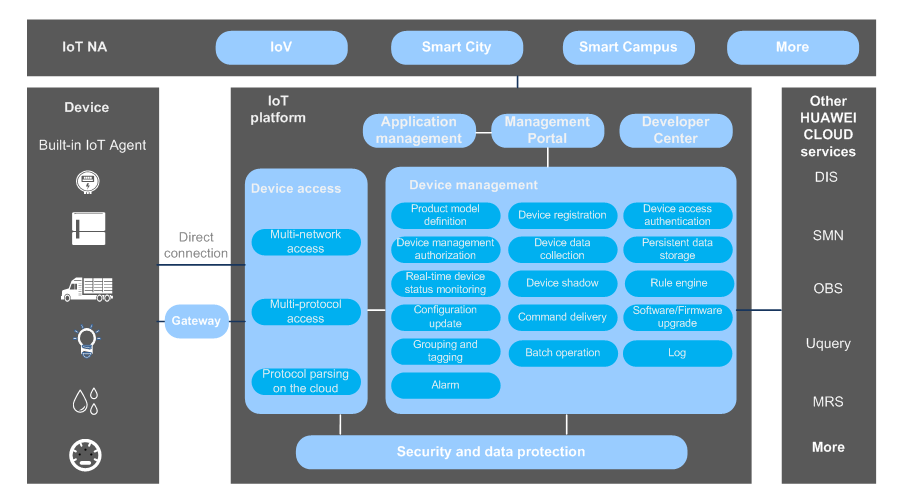Platform Overview
The IoT platform connects to and manages a large number of devices. It works with other HUAWEI CLOUD services to quickly build IoT applications.

Device Access
Devices can connect to the IoT platform directly or through industrial or home gateways. They can also access the IoT platform using a variety of protocols and different Agents through multiple types of networks. Protocols are parsed on the cloud for fast device access.
- Multi-network access: Wired and wireless access, such as fixed broadband (FBB), 2G/3G/4G/5G, NB-IoT, Z-Wave, Zigbee, and eLTE-IoT are supported.
- Multi-protocol access: Access using HTTPS+MQTTS, MQTTS, and LWM2M/CoAP is supported.
- Multi-Agent access: Agents such as AgentLite and AgentTiny, and languages including C, Java, and Python are supported. Agents are pre-integrated with chipsets and modules of mainstream brands such as HiSilicon and Qualcomm to shorten the TTM.
- Protocol parsing: The IoT platform supports access protocol and device data parsing on the cloud without converting the data format on the device side.
Device Management
The IoT platform provides a broad set of device management functions. You can manage devices on the management portal or by calling APIs.
|
Function |
Description |
|---|---|
|
Product model definition |
A product model includes the properties of a device, such as the color, size, collected data, identifiable commands, and reported events. The manufacturer, device type, and device model are used to uniquely identify a type of device. |
|
Device registration |
You can create a device and configures the device information on the IoT platform. |
|
Device access authentication |
The IoT platform authenticates devices while they are accessing the IoT platform. Information including device data integrity and security is authenticated, ensuring secure device access. |
|
Device management authorization |
The IoT platform allows an application to grant management rights of its bound devices to another application so that you can manage devices bound to multiple applications. |
|
Device data collection |
The IoT platform collects device data, such as device service data and alarms, and it allows applications to subscribe to device data. |
|
Persistent data storage |
The IoT platform stores data reported by devices and allows you to view historical data by hour, day, or month. Historical data can be stored for a maximum of seven days. |
|
Real-time device status monitoring |
The IoT platform monitors the device status in real time, and conveniently notifies you of status changes. |
|
Device shadow |
A device shadow is a JSON file used to store the reported and expected device status for NAs. Each device has only one shadow. The device can obtain and set its shadow to synchronize the status, either from the device shadow to the device or from the device to the device shadow. |
|
Rule engine |
The rule engine allows you to set rules for devices connected to the IoT platform as needed. After rule conditions are met, the devices trigger corresponding actions. The IoT platform supports the following rules:
|
|
Device configuration update |
You can deliver commands to update device properties through NAs or the management portal. |
|
Device command delivery |
You can deliver commands to remotely control devices through NAs or the management portal. |
|
Software/Firmware upgrade |
The software and firmware of devices can be upgraded in over the air (OTA) mode, and the software/firmware upgrade policies (on groups, upgrade time, concurrency control, and more) can be configured to provide flexible upgrades. |
|
Device grouping and tagging |
The IoT platform allows you to group and tag devices, thereby reducing device management costs. |
|
Batch device operation |
You can perform batch operations on devices, including batch device registration, batch configuration update, batch command delivery, and batch software/firmware upgrade. |
|
Device logs |
You can remotely maintain devices by checking device logs collected by the IoT platform. |
|
Alarms |
You can manage device alarms, including viewing alarm details and clearing alarms. |
Security and Data Protection
The IoT platform provides multiple security measures to ensure device security and effective data protection.
- Device security: A one-device-one-secret authentication mechanism is provided to prevent unauthorized access.
- Data transmission: Secure transmission channels are provided based on TLS, DTLS, and DTLS+.
- Data protection: GDPR requirements are fully met.
Application Management
The IoT platform provides you with a wide range of APIs and SDKs, including secure NA access, device management, data collection, command delivery, batch processing, and message pushing APIs.
Management Portal
You can manage devices and applications conveniently and efficiently using the management portal. The following functions are provided:
- Dashboards: provides dashboards for you to view the usage of applications and devices.
- Logs: Logs on operations (such as login, logout, and password change) and system security are recorded for fault analysis and location.
Developer Center
The Developer Center is a one-stop development tool provided by the IoT platform. It helps you conveniently develop products, devices (profile files), and codecs, perform automatic testing, and generate test reports.
Feedback
Was this page helpful?
Provide feedbackThank you very much for your feedback. We will continue working to improve the documentation.See the reply and handling status in My Cloud VOC.
For any further questions, feel free to contact us through the chatbot.
Chatbot





